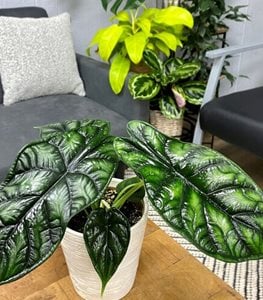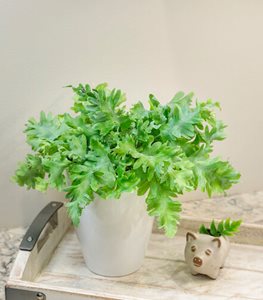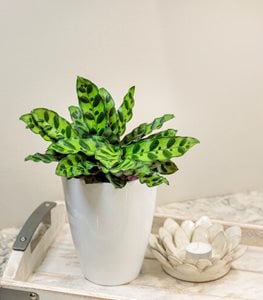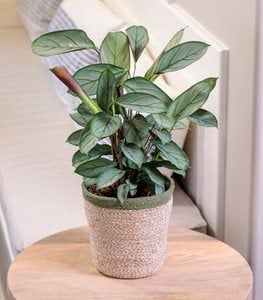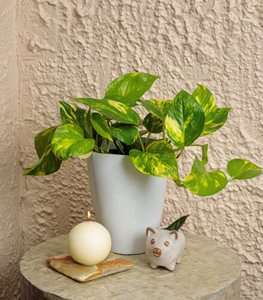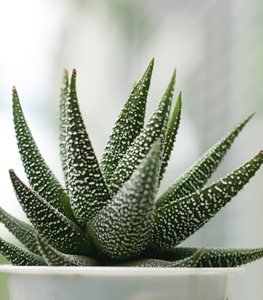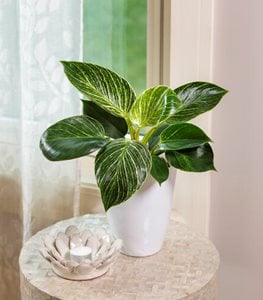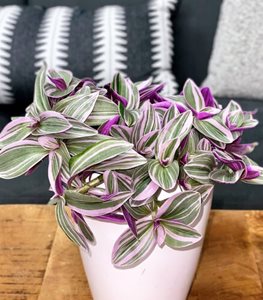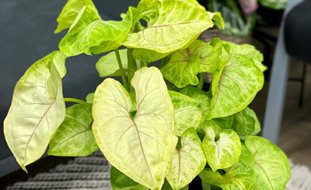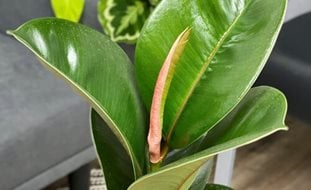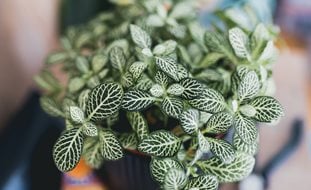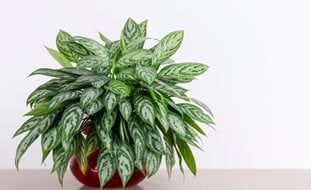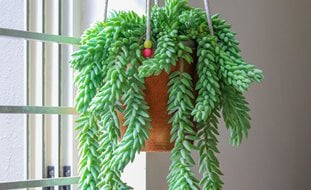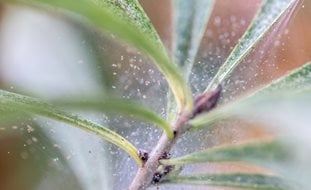10 Small Houseplants Perfect for Cramped Quarters
Make a big impact in a small space with these tabletop-friendly indoor plants.Do you need a houseplant that doesn't take up any floor space and won’t grow taller than a foot or two? These space-saving plants are the perfect solution. They will easily fit on desktops, nightstands, shelves, and windowsills, allowing you to fill any apartment or home with beautiful greenery.
The best thing about small indoor plants is that you can put them almost anywhere as long as they receive the amount of sunlight they need to thrive. Even if you have no room on a tabletop or desk, you can use small houseplants to create a beautiful indoor vertical garden by displaying them in wall-mounted planters or shelves.
On this page: Small Plants | Care Tips
On this page:
SMALL HOUSEPLANTS
ALOCASIA (Alocasia hybrids)
Size: 12 to 36 inches tall, depending on variety
Water: Water regularly during the growing season (spring through fall) to keep the soil evenly moist, but not soggy; less frequently during winter.
Fertilize: Feed with a diluted liquid houseplant fertilizer one to two times per month during spring and summer.
Although some alocasias can grow as tall as 6 feet, you can also find compact forms, sometimes called “jewel alocasias,” that are small enough to display on a tabletop or in a well-lit corner. These tropical beauties flourish in greenhouse-like conditions, so keep them away from cold drafts and don’t expose plants to temperatures below 60° F. Learn more about growing Alocasia.
BLUE STAR FERN (Phlebodium aureum)
Size: 10 to 14 inches tall
Water: Don't allow the soil to dry completely, as leaf edges will burn quickly. Water as soon as the surface feels mostly dry.
Fertilize: Feed once a month at half strength when plant is actively growing.
Not all ferns have lacy, deep green foliage. This compact variety features beautifully colored, lobed fronds that develop a powdery blue-green patina as they age. Like most ferns, it prefers bright, indirect light and humid conditions, so place in a bathroom or kitchen where it will benefit from the extra moisture. Learn more about different types of ferns.
CALATHEA (Calathea spp.)
Size: 12 to 30 inches inches tall
Water: Don't allow the soil to dry completely, as leaf edges will burn quickly. Water as soon as the surface feels mostly dry. Use distilled or filtered water, as they can be sensitive to impurities in tap water.
Fertilize: Feed once a month at half strength when plant is actively growing.
Calathea (aka rattlesnake plant) is grown for its highly decorative foliage, which comes in a wide assortment of patterns, colors, and shapes. This tropical native prefers a spot with medium to low light and ample humidity. Avoid too much sun on its leaves, which can cause scorching. Learn more about growing Calathea plants.
NEVER NEVER PLANT (Ctenanthe spp.)
Size: 12 to 36 inches tall
Water: Never never plants prefer moist, but not soggy soil. Use distilled or filtered water, as they are sensitive to impurities and salts in tap water.
Fertilize: Feed once a month with a water-soluble plant fertilizer diluted to half strength in the growing season; withhold fertilizer in winter.
Ctenanthe (along with its close relative Calathea) is sometimes called “prayer plant” because the leaves lie flat during the day and fold upward as night falls. The beautiful silvery gray, variegated foliage is sensitive to bright sunlight, so place plants in the medium indirect light of a north- or east-facing window. Also maintain a high humidity level by occasionally misting the leaves. Learn more about how to grow never never plants.
POTHOS (Epipremnum aureum)
Size: Vines 6 to 10 feet long
Water: Allow the top inch of soil to dry out between watering.
Fertilize: Light feeders, so use a balanced liquid fertilizer every 1 to 3 months.
One of the easiest houseplants to grow, this tropical vine can be trimmed and kept compact, allowed to trail from hanging baskets, or trained up vertical supports. Comes in a variety of foliage colors and patterns. Learn more about how to grow pothos plants.
Proven Winners® leafjoy® WorkLife™ Collection
Space-saving plants for desks, shelves, and tabletops.
When space and time are at a premium, choose these low-maintenance,compact, and vertical plants to take up just a sliver of space on your desk, kitchen shelf, bookshelf, or tabletop.
PEPEROMIA (Peperomia spp.)
Size: 6 to 12 inches tall
Water: Every 7 to 10 days, or when the top inch or two of soil feels dry to the touch.
Fertilize: Apply a diluted liquid fertilizer once every month or so from early spring through late summer. Do not fertilize in winter.
Small in size but big in personality, peperomia is the perfect houseplant for adorning a shelf, end table or nightstand, especially when displayed in a stylish pot. Because peperomias are native to tropical regions, they will also thrive in places like terrariums and brightly lit bathrooms. Learn more about how to grow peperomia plants.
ZEBRA HAWORTHIA (Haworthia attentuata)
Size: 3 to 5 inches tall
Water: Allow the soil to dry out completely between watering.
Fertilize: Feed infrequently using a slow-release fertilizer.
Cute and compact, this slow-growing succulent forms attractive rosettes of fleshy green leaves accented by bands of pebbly white speckles. Will tolerate low light, but prefers moderate to bright indirect light. Ideal for terrariums or any windowsill where it won’t receive direct sunlight.
PHILODENDRON (Philodendron spp.)
Size: Vines to 8 feet long
Water: Prefers evenly moist soil, but not soggy. Water if top inch of soil is dry.
Fertilize: Apply a water-soluble houseplant fertilizer from spring through fall.
Another very easy-to-grow houseplant, similar to pothos. Tolerates low light, but will grow faster in medium to bright light. Foliage comes in a variety of sizes, shapes, and colors. Philodendrons can also be grown outdoors in mild climates. Learn more about how to grow philodendron plants.
ARROWHEAD VINE (Syngonium podophyllum)
Size: Trails or climbs up to 6 feet
Water: Prefers evenly moist soil, but not soggy. Water when top inch or two of soil is dry.
Fertilize: Apply a water-soluble houseplant fertilizer from spring through fall.
This versatile houseplant is an enthusiastic climber but can be pruned to keep it compact and bushy. You can also let the vines cascade from a hanging basket. An unusual feature is that the leaves change shape as they mature, starting out arrow-shaped and becoming lobed over time. For the best results, grow in a warm, humid environment protected from direct sunlight. Learn more about how to grow arrowhead plants.
TRADESCANTIA (Tradescantia spp.)
Size: Trails up to 3 feet
Water: Tradescantias prefer moist soil; avoid overwatering to prevent root rot.
Fertilize: Use a balanced liquid houseplant fertilizer monthly.
An easy-to-grow, trailing plant that is great for beginners. Perfect for use in a hanging basket or even spilling from a regular planter. If your plant becomes leggy over time, prune it back by pinching off the stems directly above a leaf node.
See more on Feeling Flirty™ purple tradescantia from Proven Winners.
LARGER HOUSEPLANTS FOR TIGHT SPACES
Just because you live in a tiny home or apartment doesn’t mean you have to forgo owning larger plants. You can often find dwarf varieties of your favorite supersized houseplants that won’t grow as tall or wide. When young, these plants are small enough to serve as great focal points for a coffee table or desk. As they mature, they maintain a tidy, narrow growth habit so they don’t take up a lot of precious floor space. Here are some of our favorites:
Dwarf fiddle-leaf fig (Ficus lyrata): 'Bambino' (pictured) is a mini fiddle leaf with all the qualities of the full-size plant but in a much smaller package, growing no taller than 6 feet.
Rubber plant (Ficus elastica): This beautiful indoor tree can also be grown as a small- to medium-sized houseplant if you keep it in check by pruning off the top at the central stem. Keeping your plant in a smaller pot will also curb its growth. (See options for rubber plants.)
Monstera (Monstera adansonii): Mysteria™ Adansonii™ mini monstera is a compact copycat plant that is the perfect solution, growing to less than half the height.
6 DISPLAY IDEAS FOR SMALL HOUSEPLANTS
1. Display small plants at eye level, such as on a fireplace mantel or mid-level shelf, so they can be easily admired at close range.
2. Place trailing plants on higher shelves or in macrame plant hangars so the foliage can spill down and create a big impact. Pothos, philodendron, and tradescantia are examples of smaller houseplants that are more impressive when allowed to trail.
3. Group collections of small plants on a bench, windowsill, or plant stand instead of scattering them throughout a room. Plants in groups not only pack a bigger visual punch, they are also more convenient to water.
4. Use repetition to create a cohesive look. For example, try arranging the same number of plants on each level of a shelving system. You can also group plants of the same type or display different varieties of plants in containers of the same style or color.
5. Take advantage of unused wall space by installing a hanging planter system or a floating shelf for your small houseplant collection. Even a simple dowel rod can be used to support pots hung by wire hangers or S-hooks.
6. Turn a dimly lit desktop, table, or countertop into a mini greenhouse for your small houseplant collection by using single-bulb LED grow lights. You can find gooseneck fixtures that clip right onto the rim of a pot or full-spectrum bulbs that can be screwed into an existing lamp.
